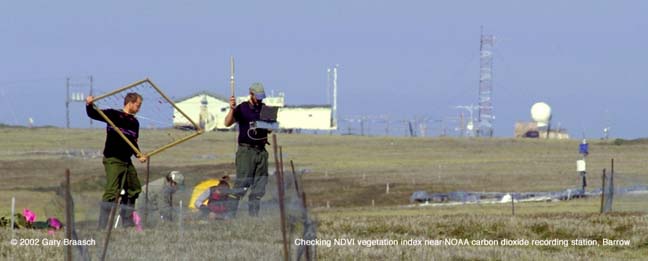Pushing the Boundaries of Life: Alaska
At the United States’ northern extremity, Barrow, Alaska, scientists are monitoring the exchange of tundra gases daily, in real time. Tundra radiation and gas flux are very intense when the ground is free of snow and plants are growing rapidly. The heat waves rippling in this photo are symbolic of the invisible flow of carbon dioxide and methane being measured by the equipment in the background. But there were visible changes too: Snow melted from the tundra a month earlier in 2002 than in previous years.
Below and on linking pages, are reports on the latest science and warming effects across Alaska and parts of the Arctic. For more on Arctic natives, please see the Arctic page. Also see Glaciers for more on Greenland and Alaska glaciers.
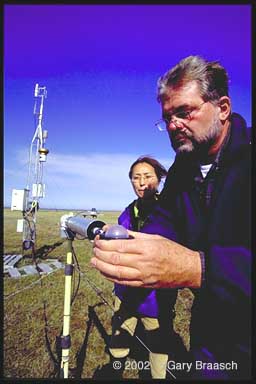
Dr. Walt Oechel and his associates from the Global Change Research Group at San Diego State University measure tundra radiation, temperature and the flux of carbon dioxide. They are the only ones in the world posting real time changes. During the past 30-35 years, Oechel has seen the moist tundra change from an important sink of greenhouse gases -- taking up and storing carbon dioxide in plant material -- to a time in the early 1980’s when the tundra was a source equal to 8% of human emissions. Now his readings show the area around Barrow is a source of emissions at night and a slightly larger sink during the day when plants are active. He suspects the tundra is changing or adapting in some way.
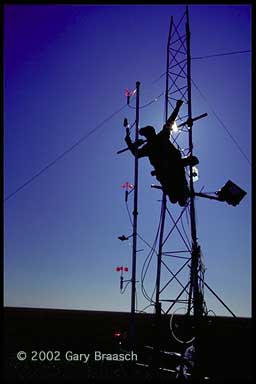
Dr. Yoshinobu Harazono, from an agro-environmental insititute in Tsukuba Japan, maintains a tower from which real-time levels of methane are sampled. Methane output, which is from decompostion and from the roots of active plants, is also increasing, probably due to the lengthening snow-free growing period in the arctic.
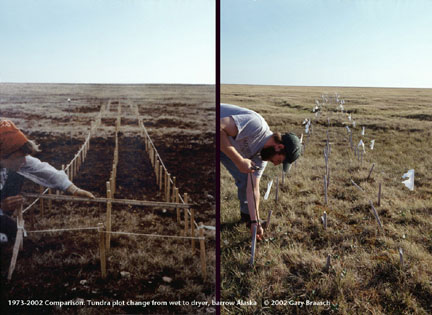
Plots in the Barrow area have been studied for more than 30 years, in part to discover if vegetation is changing due to climate warming. This location was documented in 1973 as a wet tundra, but has visibly changed to more dry-site vegetation.
Many of these sites are investigated by Dr. Craig Tweedie, a Research Fellow from The University of Queensland, Australia, working with teams from the Arctic Ecology Lab at Michigan State University. Dr. Tweedie provided the photograph on the left.
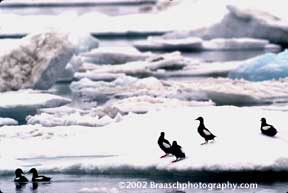
Early onset of spring is more than just a weather statistic. It impacts natives who must travel over the ice, limits the depth of seasonal permafrost re-freezing, extends the amount of time for greenhouse gas interactions by tundra plants, and is slowly changing the timing of when forage plants are available to caribou and other grazing animals. In 2003 the early thaw forced great changes in the route of the Iditarod dogsled race.
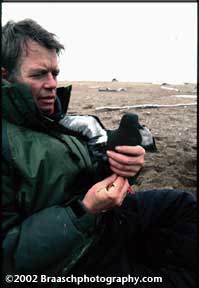
As winter gets shorter in the Alaskan Arctic, even the oil industry has been forced to make note of it. Most oil exploration and some drilling is completed in the winter when the hard frozen tundra resists most damage from the heavy equipment, and when ice roads can be made. One official response is a new study by the State of Alaska and federal Dept. of Energy: "... During the past three decades...the number of days between the opening and closing of the tundra for exploration activity has declined from over two hundred days in 1970, to only one hundred-three days in 2002.... This trend appears consistent with findings of general warming in the Alaska arctic associated with global climate change." (from DOE grant 38391, March 2003)
Next: Pushing the Boundaries of Life: Alaska
Photographs from the World View of Global Warming are available for license to publications needing science photography, environmental groups and agencies, and other uses. Stock photography and assignments available.
Use of photographs in any manner, in part or whole, without permission is prohibited by US copyright law. These photographs are registered with the US Copyright Office and are not in the Public Domain.
COPYRIGHT NOTICE:
Photography and text Copyright © 2005 - 2017 (and before) Gary Braasch All rights reserved. Use of photographs in any manner without permission is prohibited by US copyright law. Photography is available for license to publications and other uses. Please contact requestinformation@worldviewofglobalwarming.org. View more of Gary Braasch's photography here.



